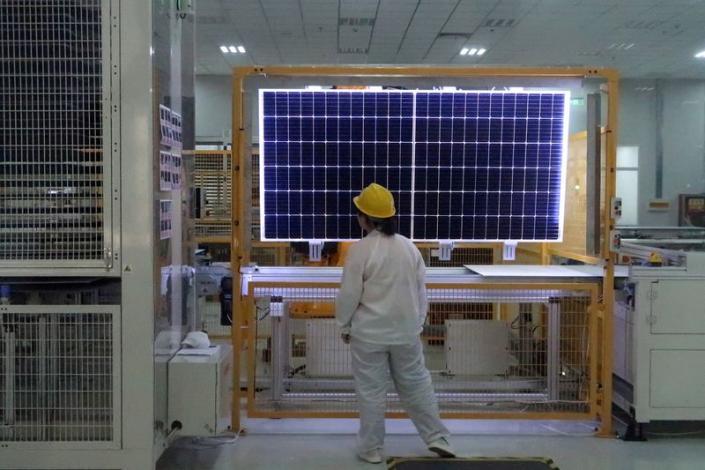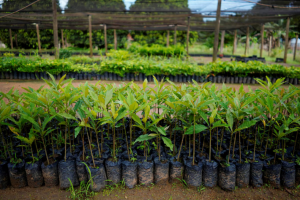China’s solar sector has continued to suffer major turbulence this year with many small to mid-sized companies having to shut down because of the country’s extraordinary overcapacity issues.
The country dominates the world market for solar energy, but an oversupply of panels caused wholesale prices to plunge by almost half in 2023 and prices have fallen further this year.
Manufacturers have been forced to cut prices below costs, which has hammered the share prices of listed companies. More than half a dozen of large firms have warned they will suffer heavy losses, but some continue to build more factories.
ALSO SEE: China Starts Merging State Brokerages, to Create $226bn Giant
The biggest manufacturers, such as Jinko, Longi and Trina, are in rocky water, but expected to survive, and perhaps prosper, given the likelihood of serious long-term demand to counter the climate crisis.
Jinko Solar said it recorded 47.251 billion yuan ($6.67 billion) in revenue in the first half and a net profit of 1.2 billion yuan ($169.4 million), which was 69% down on last year. However the group shipped nearly 44 GW of PV modules and expects shipments of another 23 GW this quarter and is confident in it will reach its full-year target of 100 GW.
Meanwhile, Longi reported revenue of 38.529 billion yuan ($5.44 billion) in the first half, which was 40% down on 2023, and posted a net loss of 5.243 billion yuan ($740 million). That was quite a turnaround from the 9.18 billion yuan ($1.3 billion) profit it recorded last year, however it shipped 44 GW of silicon wafers, 2.66 GW of cells and 31.3 GW of PV modules – and also opened a 5 GW module plant in the US.
A third giant, Trina Solar, recorded 42.968 billion yuan ($6.06 billion) in revenue in the first half, which was a 13% drop from last year. Net profit plunged by 85% to 526 million yuan ($74.2m). Still, it shipped 34 GW of models and 1.7 GWh of energy storage systems and expects to produce 55 GW of silicon wafters, 105 GW of cells and 120 GW of modules by year-end.
The data on these three conglomerates, from PV magazine, illustrates the upheaval the Chinese solar sector has endured.
Radical industry policy
It is also indicative of Beijing’s radical approach to industry support – and what the New York Times called its “high tolerance for letting firms stumble and even fail in large numbers.”
The same approach appears to have been used in the development of electric vehicles by China’s auto sector.
“China’s banks, acting at Beijing’s direction, have lent so much money to the sector for factory construction that the country’s solar factory capacity is roughly double the entire world’s demand,” the NYT’s Keith Bradsher wrote in July.
The problem for China is massive state funding causes a sort of feeding frenzy that, while it can create national champions selling products all over the world, it is also causing some local governments, their investment funds or local banks to lose large sums of money.
These ‘spare-no-expense policies’ are not only messy at home, but also cause significant resentment among its trading partners, as seen by tariffs imposed by the US, Canada and the European Union on its EVs and solar panels.
The other problem for China’s solar sector is the country’s housing crisis has meant many local government no longer have the capacity to dole out subsidies.
Another interesting factor going forward is the level of business China’s solar companies may gain from African nations, after dozens of African leaders flew to Beijing this week for the three-yearly Forum on China-Africa Cooperation Summit.
China, which is the world’s biggest bilateral lender, promised to undertake many infrastructure projects across Africa, but President Xi told his guests that he now prefers “small and beautiful” schemes based around selling advanced and green technologies, Reuters said.
The spinoffs could be a major boost for China’s solar sector, and an important part of the global fight to curb emissions.
- Jim Pollard
ALSO SEE:
China Solar Firms Are Taking Over US And No One Can Stop Them
China Building More Solar, Wind Than Rest of World Combined
China Stops Releasing Data Showing Lower Solar Power Utilisation
China Solar Panel Makers Want Beijing to Stop ‘Over-Investment’
Biden Scraps Tariff Exemption, to Protect US Solar Sector
China’s Solar Sector Seen Facing Years of Oversupply, Low Prices
China Solar Panel Costs Plunge in 2023, 60% Cheaper Than US
China to ‘Dominate’ Global Solar Supply Chain For Next Decade
























